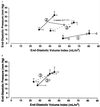An advanced glycation endproduct cross-link breaker can reverse age-related increases in myocardial stiffness
- PMID: 10706607
- PMCID: PMC16011
- DOI: 10.1073/pnas.040558497
An advanced glycation endproduct cross-link breaker can reverse age-related increases in myocardial stiffness
Erratum in
- Proc Natl Acad Sci U S A 2000 May 9;97(10):5679
Abstract
Decreased elasticity of the cardiovascular system is one of the hallmarks of the normal aging process of mammals. A potential explanation for this decreased elasticity is that glucose can react nonenzymatically with long-lived proteins, such as collagen and lens crystallin, and link them together, producing advanced glycation endproducts (AGEs). Previous studies have shown that aminoguanidine, an AGE inhibitor, can prevent glucose cross-linking of proteins and the loss of elasticity associated with aging and diabetes. Recently, an AGE cross-link breaker (ALT-711) has been described, which we have evaluated in aged dogs. After 1 month of administration of ALT-711, a significant reduction ( approximately 40%) in age-related left ventricular stiffness was observed [(57.1 +/- 6.8 mmHg x m(2)/ml pretreatment and 33.1 +/- 4.6 mmHg x m(2)/ml posttreatment (1 mmHg = 133 Pa)]. This decrease was accompanied by improvement in cardiac function.
Figures


References
-
- O'Conner C M, Friesinger G C. In: Cardiovascular Medicine. Topol E J, editor. Philadelphia: Lippincott-Raven; 1998. p. 819.
-
- Reiser K M. J Gerontol. 1994;49:B71–B79. - PubMed
-
- Norton G R, Candy G, Woodwiss A J. Circulation. 1996;93:1905–1912. - PubMed
-
- Vasan S, Zhang X, Zhang X, Kapurniotu A, Bernhagen J, Teichber S, Basgen J, Wagle D, Shih D, Terlecky I, et al. Nature (London) 1996;382:275–278. - PubMed
Publication types
MeSH terms
Substances
LinkOut - more resources
Full Text Sources
Other Literature Sources
Medical

